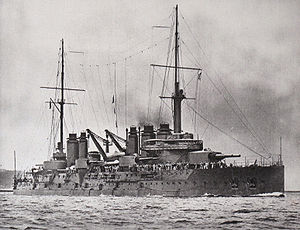
Back Дантон (броненосец) Bulgarian Danton (Schiff) German نبردناو دانتون Persian FS Danton (1909) Finnish Danton (cuirassé) French ダントン (戦艦) Japanese Danton (couraçado) Portuguese Danton (1909) Russian Danton (slagskepp) Swedish 丹东号战列舰 Chinese
 Danton
| |
| History | |
|---|---|
| Name | Danton |
| Namesake | Georges Danton |
| Ordered | 1906 programme[1] |
| Builder | Arsenal de Brest |
| Laid down | February 1906 |
| Launched | 4 July 1909 |
| Commissioned | 1 June 1911 |
| Fate | Sunk by U-64, 19 March 1917 |
| General characteristics | |
| Class and type | Danton-class semi-dreadnought battleship |
| Displacement | 18,754 t (18,458 long tons) (normal) |
| Length | 146.6 m (481 ft) (o/a) |
| Beam | 25.8 m (84 ft 8 in) |
| Draft | 8.44 m (27 ft 8 in) |
| Installed power |
|
| Propulsion | 4 shafts; 4 steam turbines |
| Speed | 19.25 knots (35.7 km/h; 22.2 mph) |
| Complement | 25 officers and 831 enlisted men |
| Armament |
|
| Armor |
|
Danton was a semi-dreadnought battleship of the French Navy and the lead ship of her class. She was a technological leap in battleship development for the French Navy, as she was the first ship in the fleet with steam turbines. However, like all battleships of her type, she was completed after the Royal Navy battleship HMS Dreadnought, and as such she was outclassed before she was even commissioned.
During her career Danton was sent to Great Britain to honor the coronation of George V, and later served in World War I as an escort for supply ships and troop transports, guarding them from elements of the German Navy. While en route to aid a blockade, she was torpedoed and sunk on 19 March 1917 by a German U-boat, leaving 296 men dead. The location of the wreck remained a mystery until an underwater survey team inadvertently discovered the battleship in December 2007. In February 2009, the wreck was confirmed to be Danton. The ship is in remarkably good shape for her age. Danton rests upright on the ocean floor, and most of the original equipment is reported to be intact.
- ^ Gardiner & Gray, p. 196.